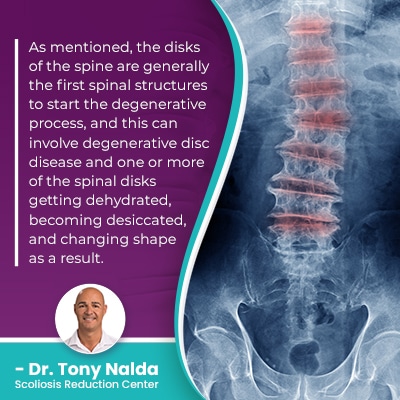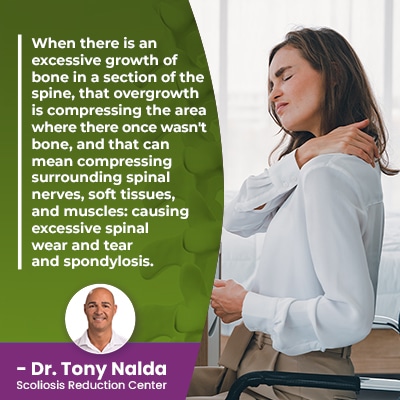Spondylosis: What Is It, Causes, Symptoms & Treatment Options
The spine is a complex structure with many important roles: keeping the body straight and upright, facilitating good posture, flexible movement, and its spinal cord within working with the brain to form the central nervous system (CNS). As such, it can develop a number of conditions/issues that involve degeneration and pain.
The spine is vulnerable to degenerative changes that occur over time, and there are a number of conditions that cause deterioration and related pain. Spondylosis isn't a condition itself, but more of an umbrella term referencing symptoms of back pain/issues related to spine degeneration.
To better understand some symptoms and causes of spondylosis, let's first explore the structure of a healthy spine.
Table of Contents
Healthy Spinal Anatomy
In order for the spine to function optimally, it has to have its natural curves and alignment in place.
The spine has three main sections, and each section has its own roles to play in spinal health and function, and its own characteristic and healthy spinal curvature type.
The cervical spine refers to the neck, thoracic spine the middle and upper back, and the lumbar spine refers to the lower back, and the health of each section is dependent on the health of the others.
The spine is made up of vertebrae (bones of the spine) that are rectangular in shape and stacked on top of one another in a straight and neutral alignment.
If the spine's vertebrae are aligned, this means its natural and healthy curves are in place, and these curves make the spine stronger, more flexible, and better able to absorb and distribute mechanical stress incurred during activity.
The spine's intervertebral disks sit between adjacent vertebrae, and when it comes to spinal degeneration, disk degeneration is often the first sign.
The discs act as the spine's shock absorbers, give the spine structure (adjacent vertebrae attach to the disc in between), provide cushioning between adjacent vertebrae to prevent friction, and combine forces to facilitate flexible movement.
In light of the discs' many important roles, it's understandable that they are the spinal structures most vulnerable to deterioration.
When it comes to general spinal degeneration, there is a certain amount to be expected with age, but the cumulative effect of a number of lifestyle choices can also play a role in the level and rate of spinal degeneration: carrying excess weight, leading a sedentary lifestyle, chronic poor posture, repeatedly lifting heavy objects incorrectly, and excessive consumption of alcohol and/or smoking.
So now that we have a basic understanding of the structure of a healthy spine, let's move on to explore the term spondylosis, and what it means.
What is Spondylosis?
As mentioned, spondylosis is not a degenerative disease itself, but it does reference symptoms of degenerative conditions that affect the spine.
Spondylosis is referencing back problems and pain that are related to degenerative changes experienced by the spine.
Conditions and issues that affect the spine also affect the spine's associated nerves and surrounding muscles.
Patients suffering from spondylosis will want the underlying cause of the spondylosis diagnosed, so not just the symptoms, but the condition itself, is being addressed.
A clinical diagnosis is necessary to design a treatment plan that can impact the degenerative conditions affecting the spine's health and function, as this can cause a number of symptoms that impact patients' quality of life: limit spine motion, chronic neck pain, neck stiffness, neck injuries, leg pain, arm pain, severe pain, chronic low back pain, disability and pain symptoms, nerve compression, and more.
In general, the area of the body located the closest to the affected spinal segment is going to feel the majority of its direct effects.
Now that we understand the term spondylosis and how its symptoms are related to the degenerative process, let's talk about causes.
Spondylosis Causes
Spondylosis can have a wide range of causes as spinal degeneration can lead to a number of spinal conditions, issues, and injuries.
 As mentioned, the discs of the spine are generally the first spinal structures to start the degenerative process and this can involve degenerative disc disease and one or more of the spinal disks getting dehydrated, becoming desiccated, and changing shape as a result.
As mentioned, the discs of the spine are generally the first spinal structures to start the degenerative process and this can involve degenerative disc disease and one or more of the spinal disks getting dehydrated, becoming desiccated, and changing shape as a result.
Disc Degeneration
When a disc changes shape due to excessive fluid loss, it tends to lose height, and as adjacent vertebrae attach to the disc in between, if a disc shifts its position, the attached vertebral bodies do as well, and this can cause the introduction of uneven forces, and as a result, uneven wear and tear on the entire spine and its individual parts.
When it comes to degenerative disc disease, once disk degeneration has started, it can be difficult to reverse the damage, and this is because the spinal disks are the largest structures in the body without their own vascular supply, meaning no direct path in and out through which blood, oxygen, and nutrients needed for repair, and waste can be removed, is available.
If a degenerative disc is left untreated, it can lead to a bulging disk and/or disk herniation.
When a disc changes its shape, its surroundings are affected, and this includes the surrounding nerve roots, and if a disc or vertebra's shift in position means it's now pressing on a nerve, nerve compression and nerve impingement can become an issue, and back pain involving nerve pain is known as one of the most debilitating forms.
Spinal Stenosis
Spinal stenosis is another condition known to cause spondylosis and involves nerve compression taking space needed for the spinal nerves to function optimally within: nerve impingement.
Spondylosis often affects the neck as cervical spondylosis; it's the cervical vertebrae that have to enable turning and bending motions, while supporting the weight of the neck and head.
One of the best ways to prevent cervical spondylosis in the modern age is to take frequent breaks from looking down at devices as this can lead to what's known as forward head posture and can introduce adverse spinal tension and spinal nerve compression in the neck.
Bone Spurs
Bone spurs are bony projections (overgrowths) that can form on the edges of bones, or where they meet, in associated joints.
 When there is an excessive growth of bone in a section of the spine, that overgrowth is compressing the area where there once wasn't bone, and that can mean compressing surrounding spinal nerves, soft tissues, and muscles: causing excessive spinal wear and tear and spondylosis.
When there is an excessive growth of bone in a section of the spine, that overgrowth is compressing the area where there once wasn't bone, and that can mean compressing surrounding spinal nerves, soft tissues, and muscles: causing excessive spinal wear and tear and spondylosis.
Conclusion
If symptoms of spondylosis, such as back and nerve pain, aren't addressed by first determining their underlying cause, pain relief will be short term, but if the underlying cause of the spondylosis is diagnosed and treated, patient improvement can mean a better quality of life.
If spinal degeneration is causing pain, a physical exam, often accompanied by an X-ray to truly see what's happening in and around the spine, can determine its underlying cause, and disc degeneration, spinal stenosis, and bone spurs can all contribute to the development of spinal osteoarthritis: another common cause of spondylosis.
If spondylosis develops in the lumbar spine as lumbar spondylosis, mild to chronic lower back pain is likely, and if spondylosis affects the cervical spine as cervical spondylosis, varying levels of neck pain is common.
When it comes to treatment options for spondylosis, that will be case-specific and depend on its underlying cause that has to be determined and guide the design of customized treatment plans.
If disc degeneration is determined as the cause, a combination of physical therapy and chiropractic care can work towards relieving pressure on the spine and its discs, addressing any spinal misalignment, and increasing core strength so the spine is optimally supported by its surrounding muscles.
Stenosis can also be addressed through a combination of chiropractic, physical therapy, and injection therapy, and sometimes, bone spurs can be absorbed by the body.
Here at the Scoliosis Reduction Center, I've treated a wide range of spinal conditions, those causing spondylosis included.
The first step to addressing symptoms of mild to chronic pain related to spinal cord compression/spinal degeneration is determining its underlying cause, and once I know what's causing the spinal degeneration, that's when I can start crafting a customized treatment plan.
While spine surgery is a form of treatment for many spinal conditions that involve compression of the spinal canal and pain symptoms encompassed by nerve roots exposed to uneven pressure, many cases of spondylosis can be improved without surgery.
Just as all surgical procedures come with their share of risks, spinal surgery is no exception; when appropriate, committing to a less-invasive form of non-surgical treatment can achieve impressive results that preserve as much of the spine's natural strength and function as possible.
Dr. Tony Nalda
DOCTOR OF CHIROPRACTIC
After receiving an undergraduate degree in psychology and his Doctorate of Chiropractic from Life University, Dr. Nalda settled in Celebration, Florida and proceeded to build one of Central Florida’s most successful chiropractic clinics.
His experience with patients suffering from scoliosis, and the confusion and frustration they faced, led him to seek a specialty in scoliosis care. In 2006 he completed his Intensive Care Certification from CLEAR Institute, a leading scoliosis educational and certification center.
About Dr. Tony Nalda
 Ready to explore scoliosis treatment? Contact Us Now
Ready to explore scoliosis treatment? Contact Us Now





